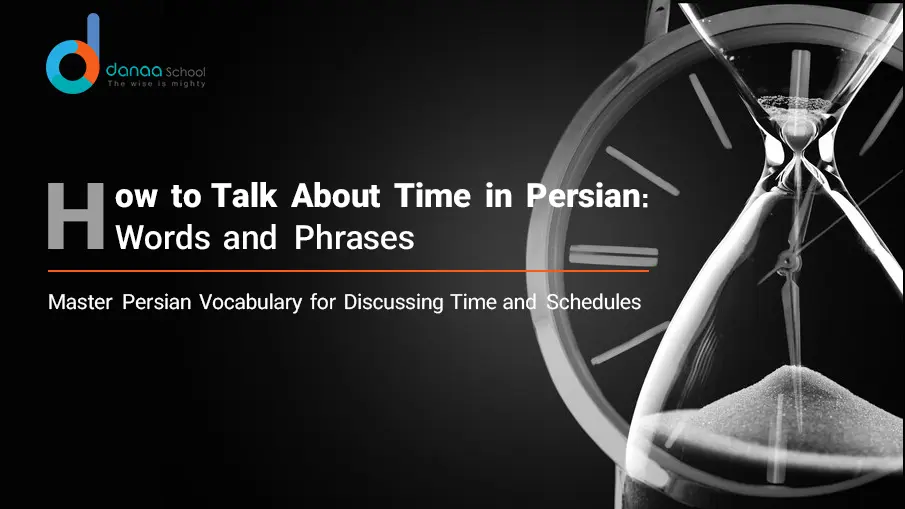How to Talk About Time in Persian (Farsi): Complete Beginner’s Guide
Being able to talk about time in Persian (Farsi) is one of the most essential skills for daily communication. Whether you want to ask for the time, make appointments, talk about your schedule, or discuss past and future events, mastering time expressions will instantly make your Persian sound more natural.
This complete guide will teach you Persian time vocabulary, how to ask and tell the time, days of the week, parts of the day, and future expressions—all with clear examples you can use immediately.
Basic Time Vocabulary in Persian (Farsi)
Let’s start with the most important time-related words in Persian. These are the building blocks you’ll use in almost every conversation.
- Time: zamān (زمان)
- Hour / Clock: sā’at (ساعت)
- Minute: daqiqe (دقیقه)
- Second: sāniye (ثانیه)
- Day: rooz (روز)
- Morning: sobh (صبح)
- Noon: zohr (ظهر)
- Afternoon: asr (عصر)
- Night: shab (شب)
- Yesterday: diruz (دیروز)
- Today: emruz (امروز)
- Tomorrow: fardā (فردا)
In Persian, sā’at means both hour and clock, and context tells you which one is meant.
How to Ask for the Time in Persian
Asking for the time in Persian is simple and commonly used in everyday conversations.
- What time is it?
Sā’at chand ast? (ساعت چند است؟) - Casual form:
Sā’at chande? (ساعت چنده؟)
The shorter form is very common in spoken Persian.
How to Tell the Time in Persian
To tell the time in Persian, you usually say the hour first and then add the minutes.
- Sā’at yek ast (ساعت یک است) — It’s one o’clock
- Sā’at haft ast (ساعت هفت است) — It’s seven o’clock
Adding minutes:
- Sā’at yek-o daqiqe panj — 1:05
- Sā’at haft-o daqiqe dah — 7:10
Special time expressions:
- Quarter past: rob’-e sā’at (ربع ساعت)
- Half past: nim sā’at (نیم ساعت)
- Ten to two: dah daqiqe be do (ده دقیقه به دو)
Persian expresses time as “minutes to the next hour,” not subtraction.
Parts of the Day in Persian
- Morning: sobh — Sā’at haft sobh ast
- Noon: zohr — Sā’at do zohr ast
- Afternoon: asr — Sā’at chār asr ast
- Night: shab — Sā’at noh shab ast
Days of the Week in Persian
- Saturday — Shanbeh (شنبه)
- Sunday — Yek-shanbeh (یکشنبه)
- Monday — Do-shanbeh (دوشنبه)
- Tuesday — Se-shanbeh (سهشنبه)
- Wednesday — Chahār-shanbeh (چهارشنبه)
- Thursday — Panj-shanbeh (پنجشنبه)
- Friday — Jom’eh (جمعه)
In Iran, the week starts on Saturday, and Friday is the main day off.
Talking About the Future in Persian
- Tomorrow: fardā — Man fardā miravam
- Next week: hafte-ye āyande
- In the future: dar āyande
Time and Culture in Persian Society
Persian culture balances punctuality with flexibility. While business settings value being on time, social events may follow a more relaxed sense of scheduling.
Iran also uses the Jalāli (Persian) calendar, a solar calendar that begins in spring and aligns closely with natural seasons.
Learn Persian Naturally with Danaa School
If you want to confidently use time expressions in real conversations, structured learning makes all the difference. At Danaa School, you’ll learn Persian through practical examples, daily usage, and cultural context—not memorization.
Find Your Ideal Teacher
At Danaa School, you can choose your Farsi tutor from a selection of qualified and experienced teachers. Begin an exceptional journey into the world of Persian language!
Book Your Trial Lesson
FAQs
How do you ask "what time is it?" in Persian?
You ask, Sā’at chand ast? (ساعت چند است؟) or more casually Sā’at chand e? (ساعت چنده؟).
What is the word for "hour" in Persian?
The word for “hour” is sā’at (ساعت).
How do you say "half past two" in Persian?
You say, Sā’at do nim (ساعت دو نیم) – It’s half past two.
What is the Persian word for "tomorrow"?
The word for “tomorrow” is fardā (فردا).
How do you say "quarter past three" in Persian?
You say, Sā’at se rob’-e (ساعت سه ربع).
What is the Persian word for "day"?
The word for “day” is rooz (روز).
Learning Time in Persian with Danaa School
At Danaa School, our approach to teaching Persian is designed to be intuitive and engaging. When it comes to mastering time in Persian, we provide clear explanations, real-life examples, and interactive activities that help students practice what they learn. Whether you’re a beginner or seeking to refine your language skills, our structured lessons on time and daily routines will give you the confidence to communicate fluently in Persian.
Learning to talk about time in Persian opens up new avenues for conversation and cultural understanding. By mastering these essential expressions and phrases, you’ll be able to navigate daily life, make plans, and engage in more meaningful interactions with native speakers. Learn Farsi now.
Want to Learn Farsi at Danaa School?
Here are the best resources for you!






